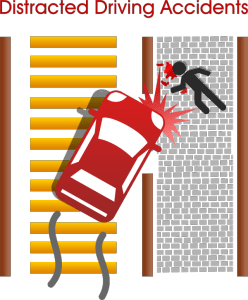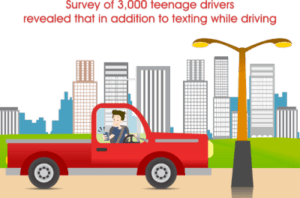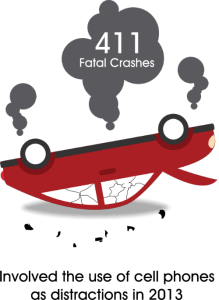The plague of distracted driving on our roads and the misery caused to so many when distracted driving accidents kill or maim car occupants and others continues with little let up.
Distracted driving in no longer a “new” or “hot” issue. Driver distractions have always been a problem, but the dangers rose exponentially with the advent of cell phones and other personal electronic devices in the first years of the 21st century.
Since 2009, the U.S. Department of Transportation has worked to raise awareness with two national distracted driving summits, and to strengthen laws, including obtaining bans on texting and cell phone use by commercial drivers (i.e., truckers and bus drivers). It has encouraged states (including ) to adopt distracted driving laws, and launched several public awareness campaigns, including Distracted Driving Awareness Month each April.
Still, there were 6,490 collisions attributed to distracted driving in Kentucky in 2013. That’s nearly 18 every day. Among them, 619 distracted driving accidents (9.5 percent) involved children age 6 to 12, one of which was a fatality.
Several studies say those figures are conservative at best. The National Safety Council said in a 2013 report that “there is no reliable method to accurately determine how many crashes involve cell phone use; therefore, it is impossible to know the true scope of the problem.”
 The NSC says figures are wrong in part because police usually have to rely on drivers involved in a crash to admit that they were on a cell phone or otherwise distracted at the time of the accident. This is unreliable for several reasons, including inability to say because of injury or simple dishonesty. In addition, if a driver is cited for a violation like drunk driving or speeding, police are likely to be unconcerned with pursuing whether distracted driving was a factor in a wreck.
The NSC says figures are wrong in part because police usually have to rely on drivers involved in a crash to admit that they were on a cell phone or otherwise distracted at the time of the accident. This is unreliable for several reasons, including inability to say because of injury or simple dishonesty. In addition, if a driver is cited for a violation like drunk driving or speeding, police are likely to be unconcerned with pursuing whether distracted driving was a factor in a wreck.
If an investigation into a crash by a car accident lawyer or others later indicates that distracted driving was the cause, it’s unlikely that accident records will be updated, the NSC says.
The warning data about distracted driving is outdated, too.
The National Highway Traffic Safety Administration on its Distraction.gov website has long relied on a U.S. DOT study that says the 5 seconds it takes the average driver to read or compose a text message is equivalent at 55 mph to traveling 100 yards blindfolded. But the author of a study released last month says “any glance away from the road for 2 seconds or longer (emphasis our) can increase the risk of an accident from four to 24 times.”
 The study’s primary author, David Hurwitz, an assistant professor of transportation engineering at Oregon State University, also says the study’s survey of 3,000 teenage drivers revealed that in addition to texting while driving, 27 percent of respondents admitted to changing clothes or shoes while driving, and some worked on homework.
The study’s primary author, David Hurwitz, an assistant professor of transportation engineering at Oregon State University, also says the study’s survey of 3,000 teenage drivers revealed that in addition to texting while driving, 27 percent of respondents admitted to changing clothes or shoes while driving, and some worked on homework.
“The absolute worst is texting on a cell phone, which is a whole group of distractions,” Hurtz says. “With texting, you’re doing something besides driving, thinking about something besides driving, and looking at the wrong thing.”
One Kentucky woman, Hillary Coltharp, found out the hard way the dangers of texting while driving along with the cold fact that it doesn’t always happen to someone else. The last time she decided to text while she was driving, her car crossed the median and flipped four times, throwing her 75 feet from the vehicle.
Hillary, who was 26 at the time, suffered a fractured skull, brain trauma, a collapsed lung and several broken bones. She has been through years of rehabilitation and therapy since her wreck and today, fortunately, is able to encourage others to avoid the mistake she made.
 Latest National Distracted Driving Statistics
Latest National Distracted Driving StatisticsIn a report released this month, the NHTSA says 2013 data show that drivers in their 20s make up 23 percent of drivers in all fatal crashes, but are 27 percent of distracted drivers in fatalities and 38 percent of distracted drivers who were using cell phones when involved in fatal crashes.
 The report says there were 2,910 fatal crashes on U.S. roadways in 2013 that involved driver distraction. This was 10 percent of all fatal crashes. There were 2,959 distracted drivers involved in fatal crashes, indicating that some crashes involved more than one distracted driver.
The report says there were 2,910 fatal crashes on U.S. roadways in 2013 that involved driver distraction. This was 10 percent of all fatal crashes. There were 2,959 distracted drivers involved in fatal crashes, indicating that some crashes involved more than one distracted driver.
There were 411 fatal crashes reported to have involved the use of cell phones as distractions in 2013 (14 percent of all fatal distraction-affected crashes). For these distraction-affected crashes, the police accident report stated that the driver was talking on, listening to, or manipulating a cell phone (or other cell phone activity) at the time of the crash.
 In the same report, the NHTSA explains in a 630-word section how terminology and reporting requirements for distracted driving crashes have changed since 2010 and therefore cannot be used to cite trends. In addition, police report forms in multiple jurisdictions across the country vary in the data they require.
In the same report, the NHTSA explains in a 630-word section how terminology and reporting requirements for distracted driving crashes have changed since 2010 and therefore cannot be used to cite trends. In addition, police report forms in multiple jurisdictions across the country vary in the data they require.
“The variation in reporting forms contributes to variation in the reported number of distraction-affected crashes,” the NHTSA says. “Any national or state count of distraction-affected crashes should be interpreted with this limitation in mind due to potential under-reporting in some states and over-reporting in others.”